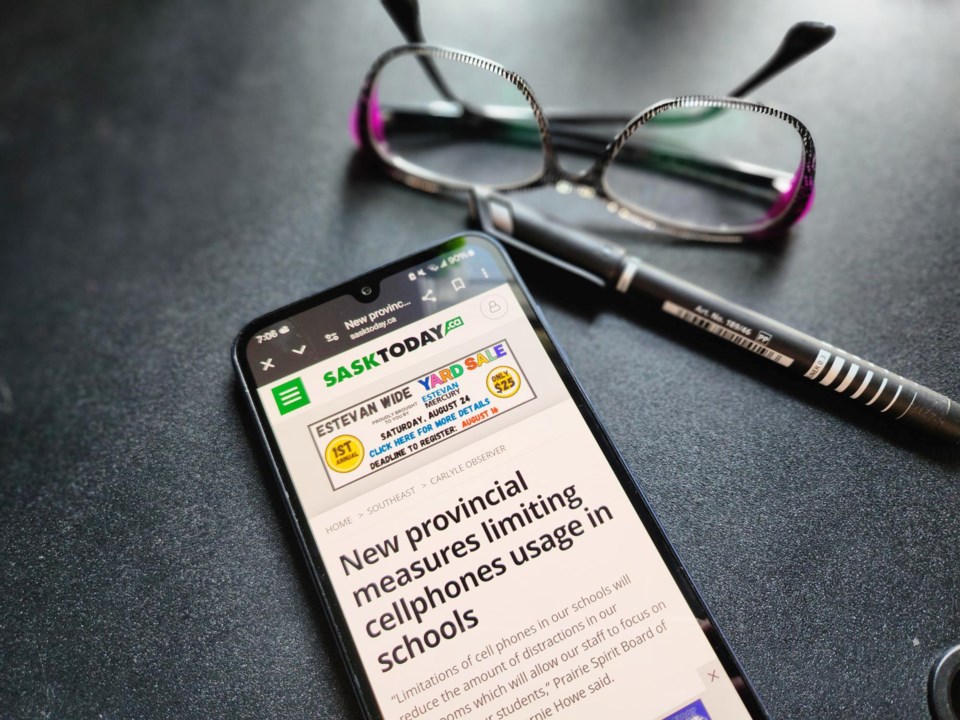As a high school student back in the day, my classmates and I had a very different relationship with technology.
Our “cell phones” were monochrome Nokia bricks with buttons, where the highlight was a game of Snake. There was no internet, no apps, and nothing remotely useful for educational purposes. These devices were so limited in functionality that they were hardly a distraction – more of a novelty item than a necessity.
Fast forward to today, where smartphones have evolved into powerful tools with the potential to both enhance and hinder education. The recent provincial legislation in Saskatchewan banning cell phones in kindergarten to Grade 12 classrooms starting in the 2024-25 school year is a response to this duality. As Saskatchewan follows other provinces in implementing this policy, one must ask: is this a necessary step to reclaim classroom focus, or is it merely a distraction from more pressing educational issues?
On the surface, the legislation seems to address a valid concern. Education Minister Jeremy Cockrill made it clear that the policy aims to refocus students’ attention on learning. He stated that “technology has its place, but too often cell phones are taking students’ attention away from what they should be learning.”
This concern isn’t unfounded; anyone who has spent time in a modern classroom can attest to the magnetic pull of a smartphone. Notifications, social media and games can easily disrupt the flow of a lesson, making it harder for teachers to maintain engagement.
Moreover, the Prairie Spirit Board of Education echoes this sentiment, emphasizing that the policy will reduce distractions and contribute to better mental well-being and academic success. In theory, by limiting the use of these devices, students might better focus on acquiring the skills and knowledge necessary for their future.
However, it’s important to recognize that many schools and teachers have already taken matters into their own hands. Policies to limit cell phone use in classrooms were already in place across various divisions. This provincial directive might provide a more uniform approach, but the question remains: How much does it actually change?
The truth is that many areas were prepared for such a policy even before it was legislated. Teachers and students alike have been moving towards solutions that balance the need for focus with the practical realities of modern technology.
For instance, at the Southeast TechHub’s innovation pitch event last spring, a group of students from St. Mary’s School presented a tech system designed to store cell phones safely during class. This system not only minimizes distractions but also addresses the concern of keeping devices secure – demonstrating that students themselves are thinking critically about how to manage technology in a school setting.
So, that brings us to the main point – the real issue may not be the phones themselves, but rather how we integrate technology into education. A blanket ban might seem like an easy solution, but it risks overlooking the benefits that smartphones can offer. Tools for research, accessibility apps for students with learning challenges, and platforms for creative expression are just a few examples of how these devices can be harnessed for educational purposes.
Critics of the ban argue that the legislation is somewhat tone-deaf, especially when there are more pressing issues in education, such as classroom resources and funding. Some question why this policy took precedence over concerns that have been loudly voiced by educators for years. In addition, the policy might be a way for the government to appear proactive without addressing the root challenges in the education system.
Moreover, there is a concern about the policy’s potential to exacerbate inequalities, particularly for students who rely on their phones for educational accommodations or lack access to other forms of technology.
In some ways, this legislation might be a case of missing the forest for the trees. The focus on cell phones could divert attention from the need for broader educational reforms and investments in technology infrastructure. If students are expected to put away their personal devices, it becomes imperative for schools to provide adequate technological resources to ensure that learning doesn’t suffer as a result.
Ultimately, while the cell phone ban may help reduce distractions in classrooms, it is not a panacea for the challenges facing today’s education system. It is a step, perhaps necessary, but one that should be accompanied by a deeper conversation about the role of technology in schools. As we move forward, it will be crucial to balance the need for focus with the benefits that modern technology can bring to education.
In my high school years, our cell phones were far from essential. But today, smartphones are a complex mix of potential and peril. Legislation like this may set the stage for more focused learning, but it also highlights the need for thoughtful integration of technology in education – an integration that respects the realities of modern students and the tools at their disposal.




